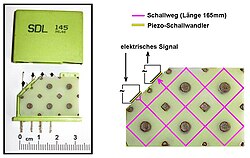




An analog delay line is a network of electrical components connected in cascade[dubious – discuss], where each individual element creates a time difference between its input and output. It operates on analog signals whose amplitude varies continuously. In the case of a periodic signal, the time difference can be described in terms of a change in the phase of the signal. One example of an analog delay line is a bucket-brigade device.[1]
Other types of delay line include acoustic (usually ultrasonic), magnetostrictive, and surface acoustic wave devices. A series of resistor–capacitor circuits (RC circuits) can be cascaded to form a delay. A long transmission line can also provide a delay element. The delay time of an analog delay line may be only a few nanoseconds or several milliseconds, limited by the practical size of the physical medium used to delay the signal and the propagation speed of impulses in the medium.
Analog delay lines are applied in many types of signal processing circuits; for example the PAL television standard uses an analog delay line to store an entire video scanline. Acoustic and electromechanical delay lines are used to provide a "reverberation" effect in musical instrument amplifiers, or to simulate an echo. High-speed oscilloscopes used an analog delay line to allow observation of waveforms just before some triggering event. Radar systems used liquid delay lines to compare one pulse of radio to another, and after World War II these were used as computer memory systems.
With the growing use of digital signal processing techniques, digital forms of delay are practical and eliminate some of the problems with dissipation and noise in analog systems.